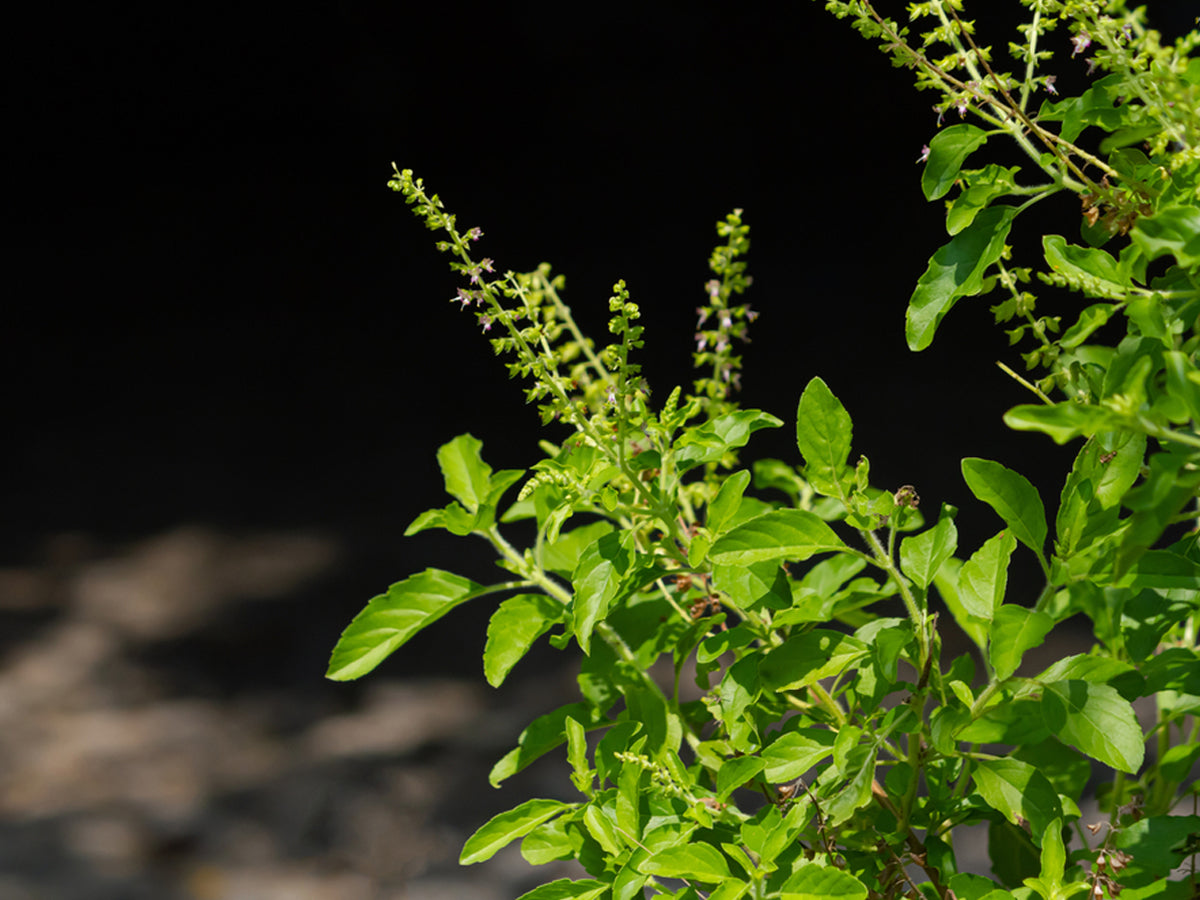How to Grow
Why You Should You Grow Tulsi at Home: Healing Power of Holy Basil
Ours is a nation that worships a plant two times a day!
But think deeply and ask yourself why Tulsi is a mandatory inclusion in every Indian household and why it is highly revered.
Modern research papers would help you find an answer. Tulsi has antifungal, anti-inflammatory, antibacterial, analgesic, antipyretic, and antiviral properties. Finding a doctor easily back then was difficult, so having a tulsi plant in the house was essential.
When it comes to Tulsi, modern medicine agrees with the world’s oldest medical system, Ayurveda. The regular ingestion of tulsi aids in the promotion of health and disease prevention. Because of this, tulsi is often added to dishes or our daily tea.
In this blog, we'll go over every facet of the tulsi herb as well as how to grow it yourself. What we will cover in further detail is listed below: -
- Fascinating facts about Tulsi or Holy Basil
- How to grow Tulsi or Holy Basil at home
- How to take care of Tulsi plant
- Amazing health benefits of Tulsi plant
Are you ready to discover Tulsi more? Let’s start then.
Fascinating Facts about Tulsi or Holy Basil
- Tulsi, also known as holy basil or Ocimum tenuiflorum, is a sacred plant in Hinduism and is considered a manifestation of the goddess Lakshmi, also known as Tulsi.
- It is native to the Indian subcontinent and is widely grown throughout Southeast Asia.
- In Hindu mythology, Tulsi is revered as the consort of Lord Vishnu and is believed to have the power to purify and protect.
- The Tulsi plant is used to produce essential oils, which are further used in aromatherapy and massage.
- In recent years, Tulsi has gained popularity in the West as a health supplement and is now widely available in the form of teas, capsules, and tinctures.
- Tulsi is a member of the mint family. The pungent smell is its identity, and that helps ward off insects.
- We Indians don't typically associate wine and basil together, although Europeans have done so for a very long time. Basil was used by the Romans as a flavor and preservation ingredient in wine. A component of the liqueur Chartreuse is basil.
- Do you know that the Orthodox churches in Bulgaria, Romania, Macedonia, and Serbia prepare holy water with basil?
How to Grow Tulsi or Holy Basil at Home
The plant is incredibly easy to grow from seeds or by rooting in water, and it only requires minimal maintenance. It can be kept indoors in a pot or planted outside in a flower or vegetable garden. Read the steps below to learn how to grow Tulsi plants at home.
Growing Tulsi from Seeds
Prepare soil and pot
Take a medium-sized flower pot and fill it up with potting soil leaving about an inch of space at the top. Follow this with thorough watering. Remember, you have to moisten the soil without making it soggy.
Sow Tulsi seeds
Get some tulsi seeds and sow them 1/4th inch deep into the prepared soil. Because tulsi seeds are so tiny, scatter them on top of the soil and use your fingers or a small tamper to gently press them into the surface.
Watering & Germination
- Keep the soil moist until the seeds sprout.
- Within one to two weeks, the seeds will start to grow.
- As the seeds are sensitive, consider misting the soil's surface with a spray bottle.
- Pour water into the pot slowly and deliberately to avoid disturbing the seeds.
- The top of the flower container should be covered with plastic wrap to help retain moisture, which will facilitate quicker germination.
- Even then, every day you should remove the wrap and check the soil to see if it requires watering or not.
Further care
- Keep this tulsi plant pot in a warm and sunny location at your home. If you are keeping it indoors, place it by a window where it can receive at least six to eight hours of bright, indirect sunlight.
- While keeping it near a window, remember that the tulsi plant doesn’t like colder temperatures, so you have to remove it from that place or close the window at night in case the temperature drops.
Growing Tulsi from Rooting in Water
Cutting a Tulsi stem
- Choose a stem right below a set of leaves and cut four to six inches of a mature tulsi stem.
- Take out all the remaining leaves from the bottom of your cutting. Leave around 2 inches of the stem entirely bare.
- While cutting the stem, take care to select a stem that hasn't flowered.
- Get a good rooting hormone from any local nursery and dip the cut end of the stem into it following instructions. It will hasten the process of root formation.
Root Formation Process
- Take a clear drinking glass or a mason jar and fill it half with water so that just the bottom half of the stem is covered in water.
- Put the Tulsi stem cutting in this glass of water. You can use more than one stem, but don’t overcrowd it.
- To avoid rotting or the formation of bacteria, change this water every day.
- Place this glass on a table or near a window or shelf where it enjoys six to eight hours of bright indirect light.
- In a week or ten days, you will see that the roots have become 1/4th to 1/2-inch long. It is now time to transplant it into a pot.
- Fill a pot with potting soil, place the stem cutting, cover it with soil, and water it nicely.
Watch it grow and enjoy the various benefits of Tulsi.
How to Take Care of Tulsi Plant
Tulsi is one of the easiest plants to grow and care for. Follow the simple tulsi plant care guide given below for a healthy plant: -
Soil
Tulsi grows in all types of soil. But the ideal one is silty loam because it is light and airy. Silty loam drains water effectively. Also, remember that the best soil mixture to use if you are growing holy basil in a pot or raised bed is three parts peat moss, one part compost, and one part perlite.
Sunlight
At least six to eight hours of sunlight is important for the growth of tulsi plants. If you expose holy basil to abundant sunlight, it will result in the growth of large, healthy leaves. Tulsi plants also enjoy some shade, but too much of it will cause deterioration.
Location
Any location in your home or garden that receives abundant light for most of the day is good for Tulsi. If the weather is too cold outside, bring the plant inside.
Water
Tulsi loves moist soil, but not a soggy one. So, examine your plant and soil twice a week to see if it needs watering. Water the soil if the surface is dry.
Temperature
Being a tropical plant, the ideal temperature for tulsi is 21 degrees Celsius.
Fertilizer
Tulsi doesn’t require any chemical fertilizer. The monthly use of compost or aged manure will be enough.
Pests & Diseases
Basil downy mildew is frequently propagated by contaminated soil sprayed up on the leaves. To stop fungus spores from splashing up from the soil, soaker hoses or drip irrigation systems might be used.
Amazing Health Benefits of Tulsi Plant
Boosts immunity
Following COVID, many tea companies began producing tea leaves infused with tulsi. That's because tulsi is an immunity booster. Tulsi can elevate your immunity levels because of the zinc and vitamin C in it. The powerful antifungal, antibacterial, and antiviral properties in tulsi leaves help our system be strong enough not to absorb any germs roaming in the air.
Antipyretic and analgesic
Tulsi leaves are antipyretic and analgesic in nature, meaning they can reduce fever and pain, respectively. Tulsi has pain-relieving properties too. Eugenol is a terpene present in tulsi that helps reduce body aches.
Prevents cold and all related issues
The elements like camphene, cineole, and eugenol in tulsi help reduce chest congestion and the common cold. Tulsi leaves mixed with honey and ginger can treat bronchitis, asthma, influenza, cough, and cold.
May have anti-cancer properties
By lowering DNA damage and causing apoptosis in precancerous and cancerous cells, tulsi aids in the elimination of malignancies brought on by harmful substances. This slows the growth of experimental tumors and improves survival.
Reduces stress, blood pressure, and diabetes
Tulsi has also been found to combat psychological stress by improving memory and cognitive function, as well as metabolic stress by normalizing blood glucose, blood pressure, and lipid levels, as well as metabolic stress through its anxiolytic and antidepressant characteristics.
Good for oral health
One of the many benefits of the Tulsi plant is that it has incredible teeth- and gum-strengthening effects. That’s why tulsi is frequently included in herbal toothpaste. Moreover, it can treat mouth ulcers and hence offer complete oral healthcare.
Great for skin & hair
Tulsi aids in acne and blemish removal from the skin. It has a high antioxidant content, which helps to delay aging. Moreover, tulsi fortifies the roots of our hair, reducing hair loss. Tulsi's antifungal qualities stop the growth of fungi and dandruff.
Helps gastrointestinal disorders
To cure indigestion and loss of appetite, you can rely on Tulsi leaves. They also help in treating bloating or flatulence.
The Tulsi plant improves the vastu of your home. By keeping a tulsi plant in the north and northeast direction, you can ward off the negative energies, according to Vastu experts. It grows on any soil type, requires minimal care, and gives back so much from skincare to liver care. So, grow a tulsi at home and take care of it by taking cues from this blog.
Happy gardening!
FAQs related Tulsi
Is tulsi a herb?
An herb is a plant that is valued for its medicinal, culinary, or aromatic qualities. They have green and tender stems, and their leaves, flowers, or roots are often used for their medicinal, culinary, and aromatic properties. Most herbs are known for their therapeutic benefits. Tulsi matches all these prime characteristics of an herb, and that’s why Tulsi is an herb.
What are the primary benefits of Tulsi?
Tulsi is believed to have antioxidant, anti-inflammatory, and immune-boosting properties, and is used to treat diseases such as colds, coughs, and digestive issues. It is also used in teas, culinary dishes, and as a natural insect repellent.
How many types of Tulsi plants are there?
There are several types of Tulsi (Ocimum tenuiflorum) plants, each with unique characteristics and properties. The most common types of Tulsi plants are Rama Tulsi (known for its use in Ayurvedic medicine to treat respiratory ailments), Krishna Tulsi (known for its purple to black leaves and is believed to have strong medicinal properties), Kapoor Tulsi (known for its strong aroma and is often used in cooking for digestive properties), Vana Tulsi (found in the wild and is known for its strong medicinal value), and Amrita Tulsi (known as the "Queen of Herbs" for its effective medicinal properties).
Apart from these Indian Tulsi varieties, there are also other types of Tulsi, such as Thai holy basil and lemon basil.
What is the Tulsi plant in English?
Tulsi is the Hindi name for the plant known in English as Holy Basil. Its scientific name is Ocimum tenuiflorum.
Where should I keep a Tulsi plant as per Vastu?
To comply with Vastu Shastra principles, planting a Tulsi plant in the north or northeast directions is recommended. As per Vastu principles, since these directions are associated with water, they are believed to help dispel negative energy and create a positive and pleasant atmosphere in the surrounding area.



